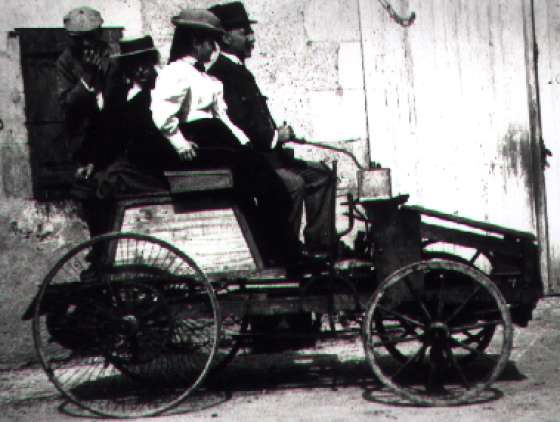- Étienne Lenoir
Infobox Scientist
name = Jean Joseph Étienne Lenoir
box_width =
image_width = 170px
caption = Jean Joseph Étienne Lenoir
birth_date =January 12 1822
birth_place =
death_date =August 4 1900
death_place =
residence =
citizenship =
nationality = French-Belgian
ethnicity =
field =engineer
work_institutions =
alma_mater =
doctoral_advisor =
doctoral_students =
known_for =Lenoir cycle ,internal combustion engine
author_abbrev_bot =
author_abbrev_zoo =
influences =
influenced =
prizes =
religion =
footnotes =Jean Joseph Étienne Lenoir (
January 12 1822 -August 4 1900 ) was a French-Belgian engineer.Born in
Mussy-la-Ville ,Belgium , by the early 1850s he had emigrated to France, taking up residence inParis , where he developed an interest inelectroplating . His interest in the subject led him to make electrical inventions including an improvedelectric telegraph .Lenoir engine
By 1859, Lenoir's experimentation with electricity led him to develop the first
internal combustion engine , a single-cylindertwo-stroke engine which burnt a mixture ofcoal gas andair ignited by a "jumping spark"ignition system by Ruhmkorff coil, [Georgano, G.N. "Cars: Early and Vintage 1886-1930" (London: Grange-Universal, 1990), p.9.] and which he patented in 1860. The engine differed from more modern two-stroke engines in that the charge was not compressed before ignition (a system invented in 1801 byLebon D'Humberstein , [Wise, David Burgess, "Lenoir: The Motoring Pioneer" in Ward, Ian, executive editor. "The World of Automobiles" (London: Orbis Publishing, 1974), p.1181.] which was quiet but inefficient), [Wise, p.1181.] with a power stroke at each end of the cylinder. [Wise, p.1182.] In 1863 the Hippomobile with ahydrogen gas fuelled one cilinder internal combustion engine made a test drive fromParis toJoinville-le-Pont : top speed about 9 km in ~3 hours [ [http://www.netinform.net/H2/H2Mobility/H2MobilityMain.aspx?ID=229&CATID=1 Hippomobile] ] .Lenoir was an engineer at
Gauthier et Cie , [Wise, p.1181.] who formed a company ("Société des Moteurs Lenoir ") [Wise, p.1181.] in Paris in 1859, [Wise, p.1181.] with a capitalization of two million "franc"s and a factory in the "Rue de la Roquette", [Wise, p.1181.] to develop the engine, and a three-wheeled carriage constructed using it. Although it ran reasonably well, the engine was fuel inefficient, extremely noisy, tended to overheat and, if sufficient cooling water was not applied, seize up. Nevertheless, "Scientific American " advised in September 1860 the Parisian newspaper "Cosmos" had pronounced the steam age over, [Citation
publication-date=1860-09-22
title=
periodical=Scientific American
publisher=
volume=
issue=
pages=p193] and by 1865, 143 had been sold in in Paris alone, [Georgano, p.9.] and production by Reading Gas Works for Lenoir Gas Engines in London had begun. [Georgano, p.9.]In 1863 Lenoir demonstrated a second three-wheeled carriage, little more than a wagon body set atop a tricycle platform. [Wise, p.1181.] It was powered by a 2543 cc (155 in3; 180×100 mm, 7.1×3.9in) [Georgano, p.9.] 1.5 hp "liquid hydrocarbon" (
petroleum ) engine with a primitivecarburettor which successfully covered the 11 km (7 mi) from Paris toJoinville-le-Pont and back in about ninety minutes each way, [Georgano, p.9; Wise, p.1181.] an average speed less than that of a walking man (though doubtless there were breakdowns). [Georgano, p.9.] This succeeded in attracting the attention of "tsar " Alexander II, and one was sent to Russia, where it vanished. [Georgano, p.9; Wise, p.1181.] (Lenoir himself was not pleased, however; in 1863, he sold his patents to "Compagnie Parisienne du Gaz " [Wise, p.1181.] and turned tomotorboat s, instead, [Georgano, p.9.] building a naptha-fuelled four-cycle in 1888.) [Wise, p.1181.]Most applications of the Lenoir engine were as a stationary power plant powering printing presses, water pumps, and machine tools. They "proved to be rough and noisy after prolonged use", [Georgano, p.9.] however. Other engineers, especially
Nikolaus Otto , began making improvements in internal combustion technology which soon rendered the Lenoir design obsolete. Less than 500 Lenoir engines of between 6 and 20 hp were built, including some under licence in Germany. [Wise, p.1181.]Granted French citizenship 1870 for assistance during the
Franco-Prussian War , [Wise, p.1182.] and awarded the "Légion d'honneur " in 1881 (ironically, not for inventing the automobile, but for developments intelegraph y), [Wise, p.1182.] Lenoir's later years were impoverished despite his engine's success. [Wise, p.1182.]Lenoir died in at La Varenne-Sainte-Hilaire on 4 August 1900. [Wise, p.1182.]
References
Notes
ources
* Georgano, G.N. "Cars: Early and Vintage 1886-1930". London: Grange-Universal, 1990 (reprints AB Nordbok 1985 edition). ISBN 0-9509620-3-1.
* Wise, David Burgess, "Lenoir: The Motoring Pioneer" in Ward, Ian, executive editor. "The World of Automobiles", p.1181-2. London: Orbis Publishing, 1974.ee also
*
Lenoir cycle
*History of the internal combustion engine
*Timeline of hydrogen technologies External links
* [http://www.newreg.co.uk/media/history/history_of_the_motor_vehicle.html History of the Motor Vehicle at newreg.co.uk]
Wikimedia Foundation. 2010.
